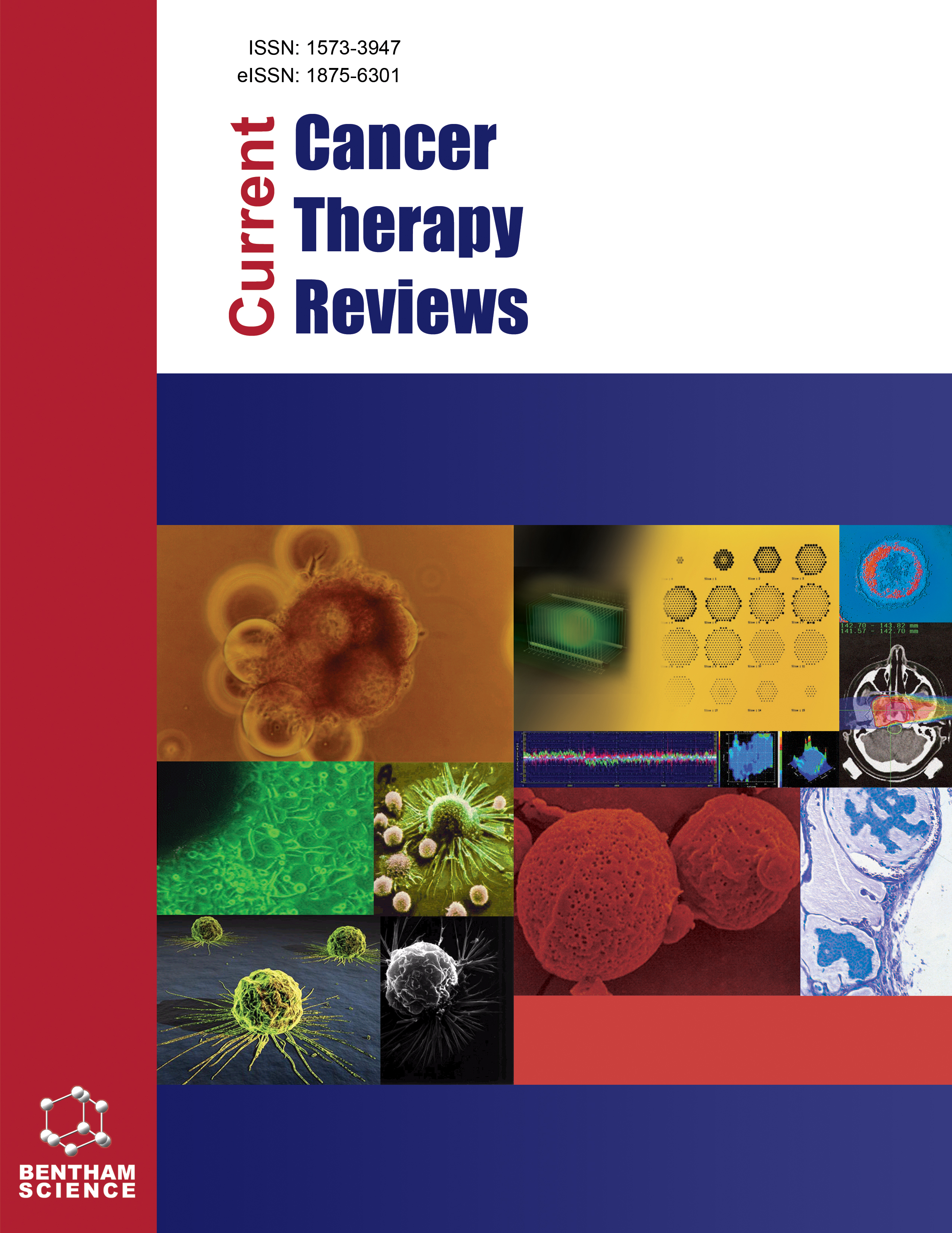- Home
- A-Z Publications
- Current Cancer Therapy Reviews
- Previous Issues
- Volume 2, Issue 1, 2006
Current Cancer Therapy Reviews - Volume 2, Issue 1, 2006
Volume 2, Issue 1, 2006
-
-
Editorial
More LessBy Allan LiptonAlthough cytotoxic chemotherapy is still the cornerstone of systemic therapy for cancer, these treatments have marginal effectiveness in many malignancies and cause significant toxicity. It is now almost 20 years ago that the epidermal growth factor receptor (EGFR) was first proposed as a potential target for cancer. The EGFR TKI's gefitinib and erlotinib have shown activity in NSCLC while cetuximab is an active agent in met Read More
-
-
-
Environmental Exposure, and Other Behavioral Risk Factors in Breast Cancer
More LessAuthors: Joanna Kruk and Hassan Y. Aboul-EneinBreast cancer continues to be worldwide public health concern in America and Western Europe as the commonest cancer among women and the second highest reason of cancer death. Epidemiological evidences implicating environmental and lifestyle risk factors in breast cancer etiology are accumulating. In this review, the current state of knowledge is reviewed, pertaining to relationship between environmental exposures (p Read More
-
-
-
New Targets, New Agents, and the Evolving Phenomena of Drug Resistance in Cancer
More LessAuthors: Shi-Ping Luh and Moulay A. Alaoui-JamaliDrug resistance is the most common cause of relapses and represents a major limitation for successful management of advanced cancers. Patients with relapse often experience an aggressive progression of the disease. The use of conventional chemotherapy drug combinations remains of limited success given the common occurrence of a broad cross-resistance toward structurally and functionally unrelated dru Read More
-
-
-
YB-1 Activities in Oncogenesis: Transcription and Translation
More LessThe Y box-binding protein 1 (YB-1) is a multifunctional DNA/RNA-binding protein regulating transcriptional and translational processes. Emerging evidence suggests a role for YB-1 in malignant human disease. Protein expression levels of YB-1 are increased in numerous human cancers, and nuclear YB-1 correlates with poor prognosis of tumor patients. However, YB-1 has also anti-oncogenic activities and interferes with phos Read More
-
-
-
HCV-Related Transformation and New Therapeutic Strategies: An Update
More LessAuthors: Clara Balsano and Anna AlisiThe hepatitis C virus (HCV) is a single-stranded enveloped RNA virus, belonging to the Hepacivirus genus within the Flaviviridae family. HCV infection has become a major worldwide health problem because it causes a chronic hepatitis leading to hepatocarcinoma (HCC) and to non-Hodgkin's B-cell lymphoma (NHL). The absence of a reliable experimental model, which mimics the physiological effect of HCV infection in human subjec Read More
-
-
-
STAT Inhibition in the Treatment of Cancer: Transcription Factors as Targets for Molecular Therapy
More LessThe ability to inhibit kinases such as Bcr-Abl, Her2, Flt3, and the epidermal growth factor receptor has ushered in a new generation of targeted therapies, based on the unique molecular abnormalities present in tumor cells. However, activation of most of these kinases is found in only a small fraction of tumors. In most cancers, a variety of kinases may become activated, but the malignant phenotype of a cell is driven through Read More
-
-
-
Free Flap Head and Neck Reconstruction After Cancer Therapy: Current State of the Art
More LessSurgical treatment of head and neck cancer, in certain cases, inflicts large tissue defects. Some of these defects are associated with devastating functional deficits and disfiguring deformities. In addition, radiation therapy, whenever necessary, often leads to wound breakdown, dehiscence and fistula formation, due to healing mechanism impairment. The advent, development, and nowadays routine use of microsurgical techniq Read More
-
-
-
Tumor Control by Manipulation of the Human Anti-Apoptotic Survivin Gene
More LessAuthors: Zakir Khan, Pratiksha Bhadouria, Radha Gupta and Prakash S. BisenSurvivin is a relatively unique member of the inhibitor of apoptosis protein (IAP) family. It contains a single baculovirus IAP repeat (BIR) domain. It is involved in the control of cell cycle and inhibition of apoptosis. Survivin is of interest because it is specifically up-regulated in cancer cells and completely down-regulated and undetectable in normal adult tissues. Thus, survivin has proved to be a promising therapeutic target for Read More
-
-
-
Recent Clinical Trials in Non-Small Cell Lung Cancer
More LessAuthors: Suresh Ramalingam and Chandra P. BelaniNon-small cell lung cancer (NSCLC) remains the most common cause of cancer-related mortality worldwide. Considerable progress has been made in recent times that have led to improved outcome for patients with all stages of NSCLC. There is increasing evidence that systemic therapy is integral for the treatment of all stages of NSCLC. Adjuvant chemotherapy has been proven in multiple recent trials to improve survival f Read More
-
Volumes & issues
-
Volume 21 (2025)
-
Volume 20 (2024)
-
Volume 19 (2023)
-
Volume 18 (2022)
-
Volume 17 (2021)
-
Volume 16 (2020)
-
Volume 15 (2019)
-
Volume 14 (2018)
-
Volume 13 (2017)
-
Volume 12 (2016)
-
Volume 11 (2015)
-
Volume 10 (2014)
-
Volume 9 (2013)
-
Volume 8 (2012)
-
Volume 7 (2011)
-
Volume 6 (2010)
-
Volume 5 (2009)
-
Volume 4 (2008)
-
Volume 3 (2007)
-
Volume 2 (2006)
-
Volume 1 (2005)
Most Read This Month
Article
content/journals/cctr
Journal
10
5
false
en


